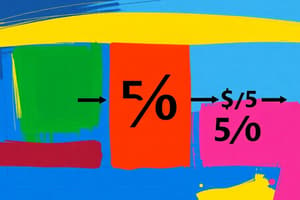Podcast
Questions and Answers
What happens to the stock value if the cash flow (D or g) increases?
What happens to the stock value if the cash flow (D or g) increases?
- There is not enough information to determine the effect
- The stock value remains the same
- The stock value increases (correct)
- The stock value decreases
What does the term $D_1/V$ represent in the equation $r = D_1/V + g$?
What does the term $D_1/V$ represent in the equation $r = D_1/V + g$?
- The expected capital gain of the stock
- The total return of the stock
- The required rate of return on the stock
- The expected dividend yield of the stock (correct)
What type of companies is the constant-growth model best suited for?
What type of companies is the constant-growth model best suited for?
- Start-up companies with high growth potential
- Companies with highly volatile growth rates
- Mature, dividend-paying companies with steady growth (correct)
- Companies with negative growth rates
What happens to the stock price if the required rate of return (r) decreases?
What happens to the stock price if the required rate of return (r) decreases?
What does the constant-growth model capture regarding the components of a stockholder's total return?
What does the constant-growth model capture regarding the components of a stockholder's total return?
What type of companies are likely to have fairly predictable growth rates in earnings and dividends?
What type of companies are likely to have fairly predictable growth rates in earnings and dividends?
Which model assumes that dividends will not grow over time?
Which model assumes that dividends will not grow over time?
What is the formula used to calculate the value of a share of stock in the constant-growth dividend valuation model?
What is the formula used to calculate the value of a share of stock in the constant-growth dividend valuation model?
What is the condition for the dividend growth rate (g) in the constant-growth dividend valuation model?
What is the condition for the dividend growth rate (g) in the constant-growth dividend valuation model?
Does the constant-growth dividend valuation model assume that the investor will hold the stock forever?
Does the constant-growth dividend valuation model assume that the investor will hold the stock forever?
What does the constant-growth dividend valuation model assume about the growth rate of dividends?
What does the constant-growth dividend valuation model assume about the growth rate of dividends?
If the investment horizon has no bearing on the computed value of a stock, what does this imply about the value calculated using the constant-growth dividend valuation model?
If the investment horizon has no bearing on the computed value of a stock, what does this imply about the value calculated using the constant-growth dividend valuation model?
Flashcards are hidden until you start studying
Study Notes
Stock Valuation and Cash Flow
- Increasing cash flow (D or g) generally leads to an increase in stock value, as it indicates higher future earnings potential.
Dividend Yield
- The term ( \frac{D_1}{V} ) represents the dividend yield in the equation ( r = \frac{D_1}{V} + g ), where ( D_1 ) is the expected dividend and ( V ) is the stock price.
Constant-Growth Model Suitability
- The constant-growth model is best suited for mature companies with stable earnings and dividend growth, such as blue-chip stocks.
Required Rate of Return Impact
- A decrease in the required rate of return (r) results in an increase in stock price, as investors are willing to pay more for the perceived lower risk.
Total Return Components
- The constant-growth model captures the components of a stockholder's total return, which include both the dividend yield and the growth rate of dividends.
Predictable Growth Companies
- Companies likely to exhibit fairly predictable growth rates in earnings and dividends typically operate in steady industries with established market positions, such as utilities or consumer staples.
No Growth Model
- The zero-growth model assumes that dividends will remain constant over time, making it suitable for companies with stable, unchanging dividend policies.
Constant-Growth Dividend Valuation Formula
- The formula for calculating the value of a share of stock in the constant-growth dividend valuation model is ( P_0 = \frac{D_1}{r - g} ), where ( P_0 ) is the price, ( D_1 ) is the expected dividend, ( r ) is the required rate of return, and ( g ) is the growth rate.
Dividend Growth Rate Condition
- In the constant-growth dividend valuation model, the growth rate (g) must be less than the required rate of return (r) to ensure the valuation remains positive and realistic.
Holding Period Assumption
- The constant-growth dividend valuation model assumes that the investor will hold the stock indefinitely, which is integral to the model's calculations.
Assumption about Dividend Growth Rate
- This model assumes a constant growth rate of dividends over time, indicating predictable growth and stability in dividend payments.
Value Calculation Implications
- If the investment horizon does not impact the computed value of a stock, it indicates that the dividend discounting methods are based on long-term growth and stable return expectations, emphasizing the model's long-term focus.
Studying That Suits You
Use AI to generate personalized quizzes and flashcards to suit your learning preferences.




